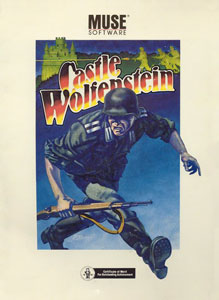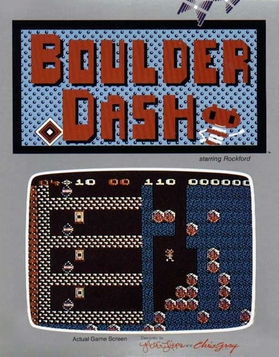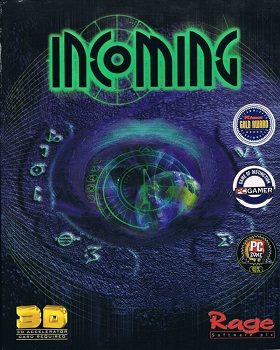
The Atari 8-bit computers, formally launched as the Atari Home Computer System, are a series of 8-bit home computers introduced by Atari, Inc. in 1979 with the Atari 400 and Atari 800. It is the first home computer architecture with coprocessors, enabling more advanced graphics and sound than most of its contemporaries. Video games are key to its software library, and the 1980 first-person space combat simulator Star Raiders is considered the platform's killer app.

Castle Wolfenstein is a 1981 action-adventure game developed by Silas Warner for the Apple II and published by Muse Software in 1981. It is one of the earliest games based on stealth mechanics. A port to Atari 8-bit computers was released in 1982, followed by Commodore 64 (1983) and MS-DOS (1984).

Boulder Dash is a 2D maze-puzzle video game released in 1984 by First Star Software for Atari 8-bit computers. It was created by Canadian developers Peter Liepa and Chris Gray. The player controls Rockford, who collects treasures while evading hazards.

Incoming is a 3D shooter video game developed and published by Rage Software. The game was first released for Microsoft Windows in mid-1998, and was followed by a Dreamcast version, which was released in Japan on December 17, 1998, in Europe on October 14, 1999, and in North America on September 15, 1999. Set in the near-future of 2009, the game primarily revolves around controlling vehicles and turrets to fight alien invaders of Earth in one of the campaign modes, the arcade mode, and with or against another player. Some levels include brief real-time strategy segments.

Spinnaker Software Corporation was a software company founded in 1982 known primarily for its line of non-curriculum based educational software, which was a major seller during the 1980s. It was founded by chairman Bill Bowman and president C. David Seuss.
Bank Street Writer is a word processor for the Apple II, Atari 8-bit computers, Commodore 64, MSX, Mac, IBM PC, and IBM PCjr computers. It was designed in 1981 by a team of educators at the Bank Street College of Education in New York City, software developer Franklin E. Smith, and programmers at Intentional Educations in Watertown, Massachusetts. The software was sold in two versions: one for elementary school students published by Scholastic and a general version from Broderbund.

Time Bandit is a maze shoot 'em up written for the TRS-80 Model I by Bill Dunlevy and Harry Lafnear and published by MichTron in 1983. It was ported to the TRS-80 Color Computer and Dragon 32, but enjoyed its greatest popularity several years later as an early release for the Atari ST. It was also released for the pseudo-PC-compatible Sanyo MBC-55x with 8-color display. Amiga and MS-DOS versions were ported by Timothy Purves.

Crossfire is a multidirectional shooter created by Jay Sullivan for the Apple II and published by On-Line Systems in 1981. Using keyboard-based twin-stick shooter controls, the player maneuvers a ship in a grid-like maze. Versions with joystick-control use the stick for movement and switch to firing mode when the button is held down.
Atari Program Exchange (APX) was a division of Atari, Inc. that sold software via mail-order for Atari 8-bit computers from 1981 until 1984. Quarterly APX catalogs were sent to all registered Atari 8-bit owners. APX encouraged any programmer, not just professionals, to submit video games, educational software, applications, and utilities. A few internally developed Atari products were sold through APX, such as Atari Pascal, the developer handbook De Re Atari, and a port of the arcade video game Kangaroo.

Many games, utilities, and educational programs were available for Atari 8-bit computers. Atari, Inc. was primarily the publisher following the launch of the Atari 400/800 in 1979, then increasingly by third parties. Atari also distributed "user written" software through the Atari Program Exchange from 1981 to 1984. After APX folded, many titles were picked up by Antic Software.
Telarium Corporation was a brand owned by Spinnaker Software. The brand was launched in 1984 and Spinnaker was sold in 1994. The headquarters were located in Cambridge, Massachusetts, USA. The President of Telarium was C. David Seuss, the founder and CEO of Spinnaker Software.
Windham Classics Corporation was a subsidiary of Spinnaker Software. The corporation was founded in 1984 and went defunct circa 1985/86 or later. The headquarters were in Cambridge, Massachusetts, USA.

Rainbow Walker is an action game designed by Steve Coleman for Atari 8-bit computers and published by Synapse Software in 1983. A Commodore 64 port followed. The player hops along a rainbow, changing monochromatic squares to color, while avoiding dangerous creatures and gaps in the surface. Coloring the entire rainbow ends the level. There are bonus rounds between levels.

Shadow World is a shoot 'em up for Atari 8-bit computers written by Mike Potter and published by Synapse Software in 1983. Players are defending their planet from an alien invasion. The game supports two players at once, splitting the screen vertically into two halves, and merging them on the fly when both players are in the same location.

Snooper Troops is a series of two 1982 adventure/educational video games developed by Spinnaker Software and published by Computer Learning Connection. They were released for the Apple II, Atari 8-bit computers, Commodore 64, and MS-DOS. The first case was entitled Snooper Troops: Case #1: The Granite Point Ghost and the second case entitled Snooper Troops: Case #2 - The Case of the Disappearing Dolphin was released later that year.

Kids on Keys is a 1983 educational video game from Spinnaker Software designed by Freeda Lekkerkerker.

The Eliminator is a horizontally scrolling shooter video game written by Terry Gilman and Wayne Westmoreland for the TRS-80 and published by Adventure International in 1981. It was ported to the Atari 8-bit family and Apple II. The Eliminator is a clone of the Defender arcade game.

Trump Castle II is a 1991 video game published by Capstone Software.

Run for the Money is a two-player business simulation video game developed by Tom Snyder Productions and published by Scarborough Systems in 1984 for Apple II, Atari 8-bit computers, Commodore 64, IBM PC, and Macintosh. The players have crash-landed their spaceships on an alien planet and compete to buy resources and convert them to goods to sell to locals in order to raise funds to repair their ships.















